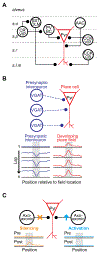Learning from inhibition: Functional roles of hippocampal CA1 inhibition in spatial learning and memory
- PMID: 35810533
- PMCID: PMC11414469
- DOI: 10.1016/j.conb.2022.102604
Learning from inhibition: Functional roles of hippocampal CA1 inhibition in spatial learning and memory
Abstract
Hippocampal inhibitory interneurons exert a powerful influence on learning and memory. Inhibitory interneurons are known to play a major role in many diseases that affect memory, and to strongly influence brain functions required for memory-related tasks. While previous studies involving genetic, optogenetic, and pharmacological manipulations have shown that hippocampal interneurons play essential roles in spatial and episodic learning and memory, exactly how interneurons affect local circuit computations during spatial navigation is not well understood. Given the significant anatomical, morphological, and functional heterogeneity in hippocampal interneurons, one may suspect cell-type specific roles in circuit computations. Here, we review emerging evidence of CA1 hippocampal interneurons' role in local circuit computations that support spatial learning and memory and discuss open questions about CA1 interneurons in spatial learning.
Copyright © 2022 The Author(s). Published by Elsevier Ltd.. All rights reserved.
Conflict of interest statement
Conflict of interest statement Nothing declared.
Figures


References
-
- Nakazawa K, Sun LD, Quirk MC, Rondi-Reig L, Wilson MA, Tonegawa S: Hippocampal CA3 NMDA receptors are crucial for memory acquisition of one-time experience. Neuron 2003, 38:305–315. - PubMed
Publication types
MeSH terms
Grants and funding
LinkOut - more resources
Full Text Sources
Miscellaneous

